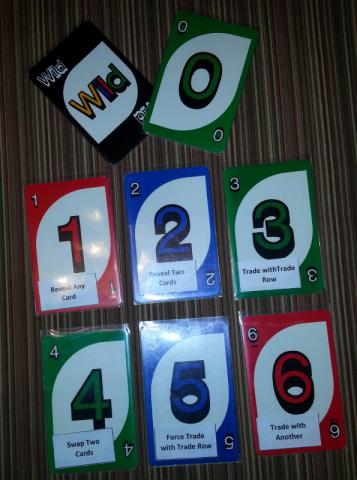Game Makeover: Nines Micro – Round 2
Design Workbench
Design Objective
It didn’t take very many more test games to figure out that a stalemate condition could arise; where Player 1 would perform an Action (or more likely 2 Actions) and Player 2 would immediately perform an Action (or likely 2 Actions) to exactly counter or undo Player 1’s Action(s). Now Player 1 is set to do the exact same thing. Details are discussed a little later in the Grid Play section.
Let’s see how we might fix this issue without creating more rules.
Playtest
Prototype
We started with the same prototype, but changed it in the middle of this test as follows. All Actions were moved to the card opposite them in the value order: The “1” Action became the “6” Action, the “2” became the “5”, etc. So now the Value-Action table looks like this:
|
Points |
Action on Card |
Player Affected |
Basic Type |
|---|---|---|---|
|
0 |
At this point I am keeping this action open. It is also worthwhile trying to keep these cards face up, by not having an action. There may also be other actions that are worth trying out. |
|
|
|
1 |
Reveal a card in any player’s grid. |
Either (+/-) |
Reveal |
|
2 |
Reveal two cards in your own grid. |
Self (+) |
Reveal |
|
3 |
Trade a card in your grid with the Trade Row. Initially, the card must be revealed, but also try concealed cards and leave them at their current state (revealed/concealed) in the Trade Row. |
Self (+) |
Trade |
|
4 |
Swap any two cards in your grid. |
Self (+) |
Move |
|
5 |
Force another player to trade a card with their choice of card from the Trade Row. Initially, the player forcing the trade can designate the card to trade, but also try allowing the affected player to choose. |
Other (-) |
Trade |
|
6 |
Trade a designated card with another player. The player taking the Action gets to select both cards. |
Self (+) Other (-) |
Trade |
The cards now look like the ones pictured here.
Playing
The Draft
My son and I just played the draft part of the game multiple times trying the two different point-action systems to see how the system affected the strategy:
- Coincident Value: Low point (high value) cards have high value actions.
- As noted before, the choices are pretty obvious here.
- Counter Value: Low point (high value) cards have low value actions.
- Wow! The player may set out on a completely different strategy based on the cards that are available and the cards taken by the opponent.
Although the typical decision is still very simple, having any decision and a better chance of getting something useful mitigates the luck of the draw.
Grid Play
An unintended consequence of combos is potential stalemate. Since an action card is concealed to use its action, without the first player switch each round it would take two turns to use that action again and the other player could change their grid to prohibit making the exact same action. With the first player switch, though, a player can repeat the exact same action and the other player can take the exact same defensive action to undo it; thus creating a stalemate scenario. An option to deal with this could be to introduce new rule(s) to prohibit or mitigate the potential: (with some quick observations)
- Temporarily lock a card that has just been either used for its action or manipulated by an action.
- Prohibits player from using it differently.
- Conceal a card that has just been acted upon by an Action.
- Assumes that Actions cannot be performed on concealed cards.
- Slows game play – the objective is to reveal all the cards. Another cause to conceal them draws out the game.
- Prohibit taking an exact opposite action (an undo action).
- Not horrible.
- Prohibit using the exact same action two turns in a row.
- Not horrible, but more to track.
- Institute a threefold repetition rule as in chess that immediately initiates the end game when the same play has been made three times in a row.
- Could be catastrophic to the game – could happen on round 1-2-3.
Ultimately, introducing a new rule is not desirable; especially since one of the main objectives of micro-sizing the game is to trim it down to the absolute minimum rules. So a system approach would be far better. A change to the Counter Value Method for the point-action system may be the key.
New Rules
The objective of this round was to mitigate the stalemate condition without introducing new rules. So far, it appears that we have accomplished this, so no new rules are introduced here.
Working It Out
So have we made any progress with these changes? There are several impacts of these changes with the most dramatic listed here.
- Few Decision: The Counter Value system increases the number and complexity of decisions available.
- Multiplayer Solitaire: The Counter Value system also adds more risk-reward calculation to interactions so knowing what is in the other player’s grid is more important.
- Game Length: The game doesn’t appear to necessarily take any longer, but with more analysis comes more time. More playtests are necessary to determine this impact.

